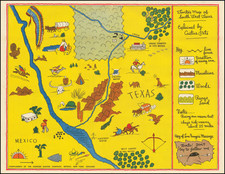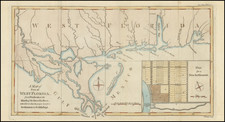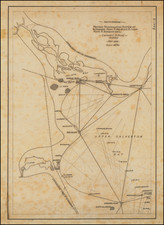An extraordinarily rare promotional map published by Patillo Higgins, the Father of Texas Oil, just months after the gusher at Spindletop transformed the global oil industry.
Born in Sabine Pass, Texas in 1863 but spending most of his life in Beaumont, Higgins’ early years were marked among other things by violent racism and the killing of a sheriff’s deputy, though in his early twenties he found religion. He worked first as a logger, then invested in real estate and brick manufacturing, along the way becoming an amateur geologist. An intensely stubborn man, in the early 1890s he went against the prevailing scientific wisdom, bought land at a salt dome outside Beaumont known as “Spindletop,” and formed a partnership to drill for oil. The effort faced enormous financial and technical obstacles, but after a number of stops and starts the drillers struck oil on January 10, 1901, with the well flowing at the extraordinary rate of some 100,000 barrels per day—more than all other wells in the country combined. The ensuing frenzy was extraordinary: the area’s population exploded, real estate prices skyrocketed, fortunes were made and lost, and innumerable frauds perpetrated on a gullible public. Soon more than 200 wells dotted the hill, leading to a short-lived oil glut until production plunged within a couple of years.
By the time of the great gusher at Spindletop, Higgins had long since been frozen out of the partnership, but he sued the drillers and obtained an out-of-court settlement. This, combined with his now immensely-valuable real estate interests in the area, provided a financial platform for him to establish Higgins Standard Oil Company in 1902. As the name suggests, his intention was to establish a vertically-integrated oil empire on the model of John D. Rockefeller’s Standard Oil. Unfortunately for Higgins, the offering seems to have failed: In the words of writer Daniel Yergin, “the public had become wary of any more stock offerings bearing the imprint of “Swindletop.”” (The Prize, chap. 4)
Higgins published this map to promote a $10 million stock offering to fund his grand—or perhaps grandiose—vision. The map depicts East and Central Texas, all of Louisiana and a small portion of Mississippi, with county boundaries indicated by dashed lines and solid lines delineating the region’s extensive rail network. Its real point, though, begins with the four small colored areas indicating parcels (“Oil Fields”) owned by Higgins, including “Higgins Oil Field #1” at “Spindletop.” Fields 1, 2 and 3 are colored red to indicate their ownership by Higgins in fee simple; Field 4 is yellow, indicating that he held it under a lease. The map lays out Higgins’ vision of a network of pipelines to move oil from his Company’s fields to its own refineries to be built outside Houston and on Sabine Lake. From there the refined oil would then either be shipped by one of the many existing rail lines emanating from Houston or piped to Sabine Pass and loaded on tankers.
I am aware of one example of the map held in a private Texas collection, but it appears to be absolutely unrecorded in the standard bibliographic sources, and I find no record of its having appeared on the antiquarian market.
Pattillo Higgins (1863 – 1955) was a hugely controversial firebrand of Texas oil and the single most instrumental figure in the dawn of the Texas oil boom. With Anthony Francis Lucas, he discovered and led the exploitation of Spindletop, the oil field in Jefferson County that would propel Texas, and the United States, to the role of top oil producer in the world.
Higgins was born on December 5, 1863 in Sabine Pass, Texas. By the age of six his family relocated to Beaumont, where after completing fourth grade, Pattillo apprenticed as a gunsmith with his father.
When Higgins was 17, he was caught harassing an African American Baptist church by a sheriff’s deputy. The deputy shot at Higgins, who returned fire, hitting the deputy, who would eventually die of his wounds. Pattillo suffered a gunshot wound to his left arm that required amputation below his elbow. Pattillo claimed self-defense and was found not guilty by a jury. After a stint as a “one-armed logger” on the Texas-Lousiana border, Pattillo became a Christian thanks to Baptist revival meeting he attended in 1885.
Higgins’ entrepreneurial spirit led him to real estate and brick manufacturing (Higgins Manufacturing Company) and later on sparked his interest in oil and gas. He travelled to Pennsylvania to learn about geological features indicating underground repositories of oil and dedicated himself to study of US Geological Surveys and reports that led him to the realization that many of the signs pointed to Sour Hill Mound (“sour” due to sulphur odor) near Beaumont, that he often visited with his Sunday school students. At this period in time the universal agreement was that there are no significant oil reserves to be found along the Gulf coast, but Pattillo became convinced that this salt dome mound had oil below it and despite public attacks on his credibility, he partnered with George O'Brien, George Carroll, Emma John, and J.F. Lanier to form the Gladys City Oil, Gas, and Manufacturing Company in 1892. This venture proved unsuccessful due to the shifting sands and unstable clay under the hill. Higgins resigned from the company, while retaining lease to the site.
After placing numerous adds in industrial magazines, Higgins partnered with the only man that answered – Croatian-America Anthony Francis Lucas. Lucas leased land at Spindletop Hill from Higgins and after years of arduous drilling discovered oil at what would become known as the Lucas Gusher. The relationship between Higgins and Lucas was quickly strained, but all made money. Higgins would enter into numerous oil ventures afterward, however, most of the time he backed out, leaving the majority of the profits to his partners.
Higgins remained a bachelor until the age of 45. In 1905, he adopted a young woman named Annie Jahn, who at the time was fifteen. Three years later Higgins married her, and despite the scandal, they later had three children. Higgins died in San Antonio on June 5, 1955.













![[ Texas - Dallas to El Paso ] Flight Chart- Dallas Fort Worth to El Paso, U.S.A.](https://storage.googleapis.com/raremaps/img/small/98371.jpg)
![[ Mississippi ] Carte Geographique, Statistique Et Historique Du Mississippi](https://storage.googleapis.com/raremaps/img/small/76150.jpg)